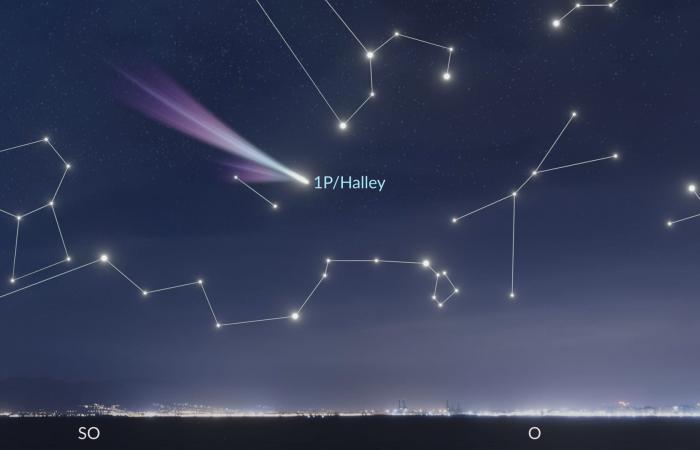Imagine a 200,000-year-old celestial body made of dust and ice that travels through space and makes its grand appearance in Earth’s sky every 76 years. This is Halley’s Comet, a wonder that has fascinated people for centuries! The comet is already on its way to Earth and will appear again in 2061. Do you want to know more about how Halley’s Comet “invented” anti-comet pills or how you can see the comet’s tail twice a year? Keep reading to learn more!
Content
Halley’s Comet repeatedly returns to Earth’s sky, easily visible to the naked eye. It fascinates both astronomers and casual observers and occupies a place on the list of big kites.
Probably the most famous of all comets, became the first comet whose return was predicted. Before that, everyone thought comets could only pass through our solar system once! However, in 1682, Edmund Halley used Isaac Newton’s theories to discover that the comet he saw was the same one seen in 1531 and 1607. He predicted that it would return in 1758. Halley did not live to see it, but the comet did return and was named in his honor as Halley’s Comet. The official name of the comet is 1P/Halley; the “P” stands for “periodic”, indicating that it returns periodically, and the “1” means that it is the first comet identified as periodic.
The relatively predictable and short orbit is what made Halley’s Comet famous. But – as with most things in nature – Halley’s Comet’s orbit is not exactly predictable.
Halley orbit
Halley’s Comet is a short-period comet, meaning it takes less than 200 years to orbit the Sun. If you think that’s a long time, think again — there are long-period comets that orbit the Sun alone. once every 6 million years. Take, for example, C/1999 F1 (Catalina).
Averaging 76 years, 1P/Halley’s orbit varies between 74 and 79 years due to gravitational influences from large planets like Jupiter (this gas giant can push or pull the comet out of its orbit). The comet’s trajectory is very stretched: On a scale where 0 is a perfect circle, and 1 is a parabola, Halley’s Comet is 0.967! You can get closer as close to the Sun as 0.59 AU (between Mercury and Venus) and as far away as 35 AU (near Pluto).
Halley’s Comet is a bit of a rebel in the Solar System — it has a retrograde orbit, moving in the opposite direction to most bodies here, with an inclination of 18 degrees to the ecliptic. It also boasts impressive speed, reaching 70.56 km/s during its close pass by Earth in 1910although it is reduced to about 1 km/s at its farthest point from the Sun. It’s not unusual, however: according to Kepler’s second law of motion, a celestial body moves faster when it is at perihelion and slower when it is at aphelion.
Twice a year, the Earth crosses the orbit of Halley’s Comet, and we can see comet fragments burning up in our atmosphere. This event is called a meteor shower.
Halley meteor showers
Every May and October, Earth passes through Halley’s residual particles, creating the Eta Aquarid and Orionid meteor showers.
This is possible because, Over thousands of years, Halley’s Comet has left a trail of debris throughout its orbit around the Sun. That is why the comet does not need to be close to the Earth or the Sun to produce a meteor shower. When Earth passes through this trail of comet debris, these small particles (often no larger than grains of sand or gravel granules) collide with our atmosphere at high speed and burn up, creating bright streaks of light in the sky. sky — meteors.
By the way, comets are not the only ones that produce meteor showers. Learn more about meteor showers and their parent bodies in the dedicated article.
What is the estimated remaining life of Halley’s Comet?
Some people might think that if we see parts of Halley’s Comet burning up in our atmosphere twice a year, it means the comet is gradually disintegrating. This is true, but the process is not as quick as one might think.
NASA estimates that each time Halley’s Comet orbits the Sun, it loses about 1 to 3 meters of material from the surface of its core. British astronomer David Hughes, considering the comet’s current mass and its estimated rate of mass loss per orbit, concluded that the comet has probably completed about 2,300 orbits around the Sun. It could also potentially survive another 2,300 orbits. Considering that each orbit lasts approximately 76 years, we get approximately 175,000 more years of life for Halley’s Comet. But keep in mind that this is probably just a very rough estimate!
A more recent study highlights that Halley’s Comet has a very unpredictable orbit, making its future trajectory difficult to predict even just 100 years ahead. This research also indicates that The comet could be ejected from the Solar System or possibly collide with another celestial body in just 10,000 years.
Comets are, in fact, dynamic and unpredictable. One thing we can say with certainty is that Halley’s Comet is scheduled to return in 2061!
Halley’s Comet will reach its closest point to the Sun on July 28, 2061. On its way towards the Sun, during the late spring and early summer, it will be visible in the morning sky and will favor observers in the Northern Hemisphere. The view from Earth should be favorable, as the two objects will be on the same side of the Sun. We can only imagine what technologies will be used to study the comet at that time!
Where is Halley’s Comet now?
Halley’s Comet has already passed aphelion on December 9, 2023 and is currently on its way towards the Sun. It is surely too faint to be visible, considering that the comet is about 35 AU from us, but the most curious can find the location by 1P/Halley in the sky on the Sky Tonight app. Curious fact: It currently takes approximately 5 hours for the comet’s reflected light to reach us.
To imagine 1P/Halley’s journey through the Solar System, here are the dates that Halley’s Comet will cross the orbits of the planets as it approaches the Sun. Remember that, as we said above, the comet moves more faster the closer it is to perihelion.
- May 7, 2041: Neptune
- May 1, 2053: Uranus
- December 7, 2058: Saturn
- June 25, 2060: Jupiter
- May 16, 2061: Mars
- June 19, 2061: Earth
- July 9, 2061: Venus
Halley’s Comet will reach perihelion again on July 28, 2061.
Did you know?
-
Halley’s Comet inspired the Messier Catalog: In 1758, French astronomer Charles Messier, while searching for the comet predicted to return that year by Edmond Halley, sighted a fuzzy object in Taurus. Although it looked like a comet through his telescope, it did not move relative to the stars from night to night. This object, known as M1, became the first entry in Messier’s catalog, which lists objects that could be mistaken for comets.
-
There is a group known as Halley-type comets.: This group unites atypical comets that resemble Halley’s Comet — they have orbital periods between 20 and 200 years and orbits that can be highly inclined with respect to the ecliptic. Typical periodic comets have an average inclination to the ecliptic of only ten degrees and an orbital period of only 6.5 years. Currently, there are more than 100 known Halley-type comets.
-
The first reliable observation of Halley’s Comet dates back to 239 BC: On March 30, 239 BC, Chinese astronomers recorded the first documented passage of Halley’s Comet, mentioned in the chronicles Shih Chi and Wen Hsien Thung Khao.
-
In 1910, people bought anti-comet umbrellas to avoid the “poison” of 1P/Halley: When spectral analysis revealed poisonous gases such as cyanogen and carbon monoxide in the tail of Halley’s Comet in 1910, there was widespread panic. With the Earth predicted to pass through the comet’s tail, the tabloids claimed that these gases could wipe out all life. In response, people desperately bought anti-comet pills and umbrellas to protect themselves from the supposed threat.
For more fun facts about great comets throughout history, try our quiz. You will not be disappointed!
What do comets have to do with Cognac and the American Civil War?







